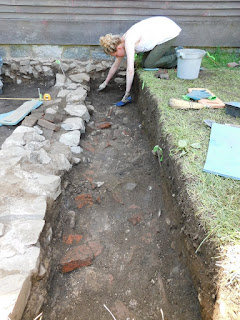Mercantilism and the Emergent Elite at Strawbery Banke
Hi everyone! My name is Lillian Page and I am currently studying cultural anthropology at Santa Clara University. I live in Rye, NH and was so excited to have the opportunity to work at a museum I have visited many times! I participated in the Strawbery Banke field and lab school in order to gain more experience to apply to my future studies.
Being a merchant in the 18th century was not only a career but a lifestyle. John and his son Joseph Sherburne were mariners and merchants who sold textiles, clothing, building materials, grains, and foodstuffs through a shop connected to the Sherburne House (Harrington 11). Artifacts found at the Sherburne site suggest that merchants were of a higher social class and used their wealth to reflect and advertise their business.
For my project, during the lab session, I sorted through artifacts from previous digs at the Sherburne house and selected examples that reflected the lifestyle of the Sherburne family. Then, I researched and interpreted how they were used in society, specifically those predominantly used by merchants and elite.
( (Wig curler c.1720)
This is a fragment of a wig curler found at the Sherburne site. It is made from kaolin clay, a type of clay that was imported from China. At the beginning of the 18th century, it was more common for men to wear wigs than women. The styling of the wig was used as a mark of status and was associated with wealthy higher-class members of society. Curlers were heated in the fire, curled, and manipulated with dressings and oils for color and texture (White 116). Lost and stolen wigs were often advertised in newspapers because of their worth.
(Thimble and chain, c.1730)
The chain in this photo was perhaps from a chatelaine or waist-hung appendage that was used as a purse to carry small personal items (White 129). The thimble shown could have been one of the items one would carry in a case hanging from a chain. Other personal items carried include mirrors, fans, scissors, coin purses, needle cases, and lockets.
(Paste gems, c.1700)
The gem on the left is clear with an engraved cipher, often personalized initials. The gem on the right reflects one of the many motifs carved. Flowers, bows, and feathers were also used. Paste gems are faceted glass made from flint and lead oxide. They were highly desired by the wealthy middle class for decorations on jewelry, buckles, and clothing (White 99). Using genuine stones had a risk of being lost or stolen and became a popular alternative. Paste gems were also popular because they were easy to cut into an array of shapes and colors in comparison to stones and gems.
(Cosmetic spoon, c.1700)
This cosmetic spoon is comprised of copper alloy. It would have been used to hold ointments, powders, cosmetics, to manicure the nails, and even to scoop earwax for sewing (White 122)! Cosmetic spoons were purchased and used by wealthier men and women, as they were not a necessity.
References:
White, Carolyn L.2005. American Artifacts of Personal Adornment 1680-1820. Oxford U.K..
Harrington, Faith. 1989. “The Emergent Elite in Early 18th Century Portsmouth Society: The Archaeology of the Joseph Sherburne Houselot.” Historical Archaeology, Volume 23.





Comments
Post a Comment